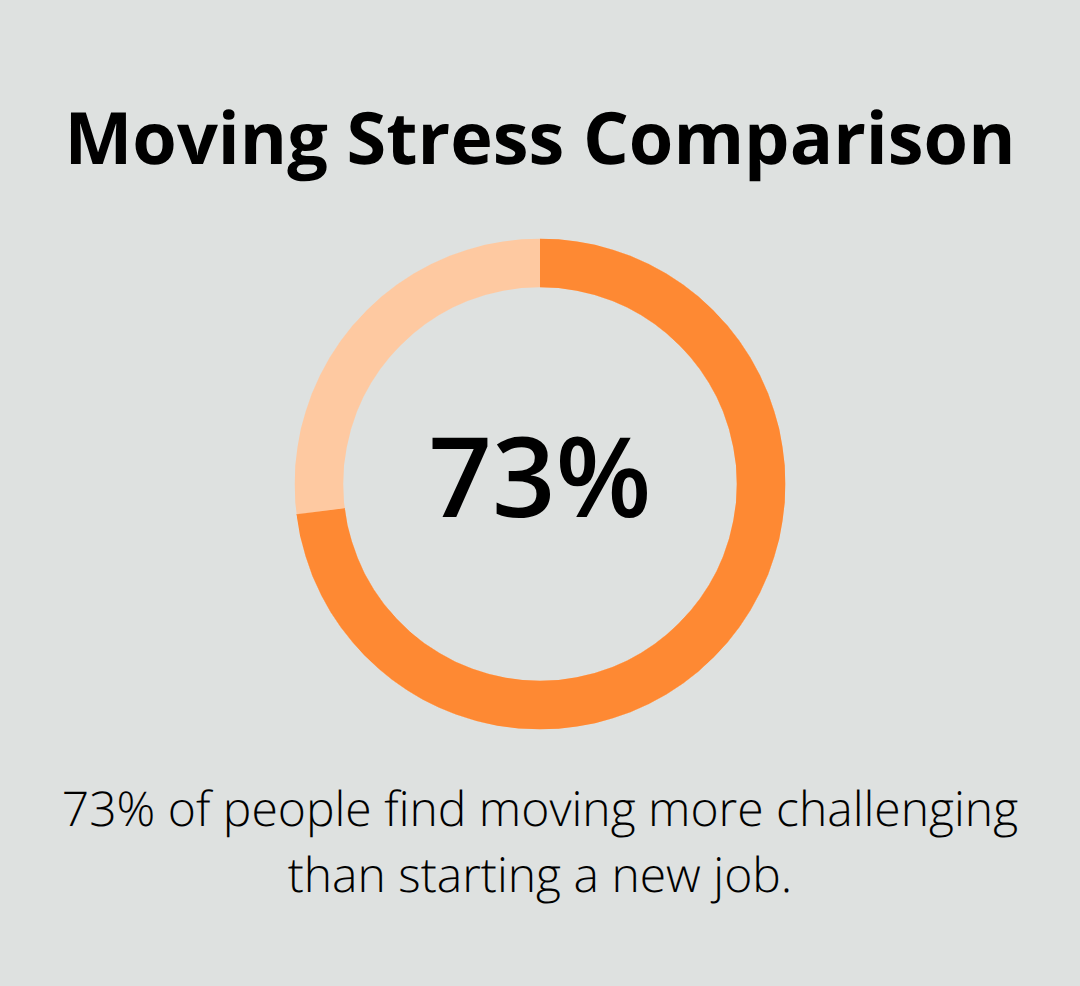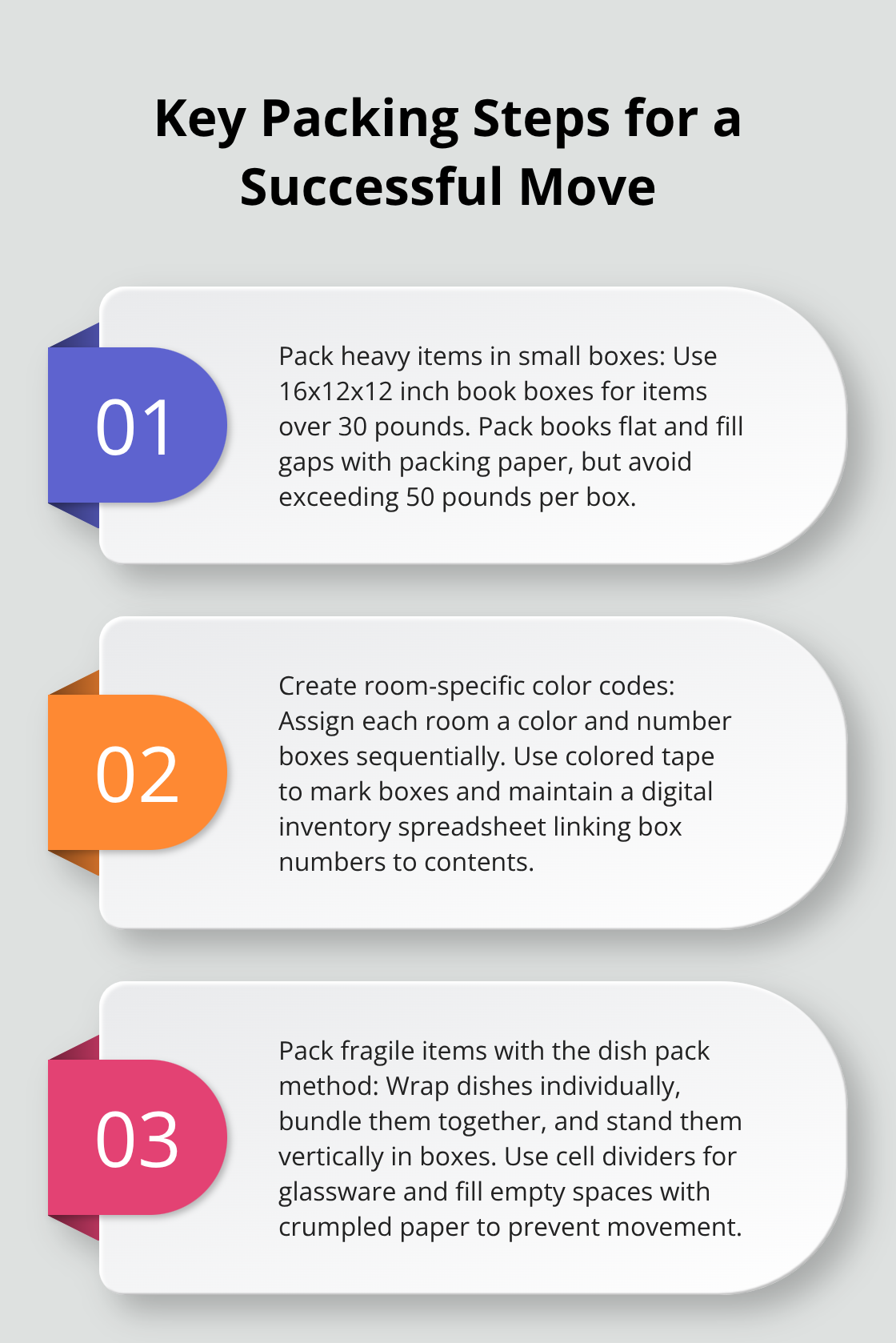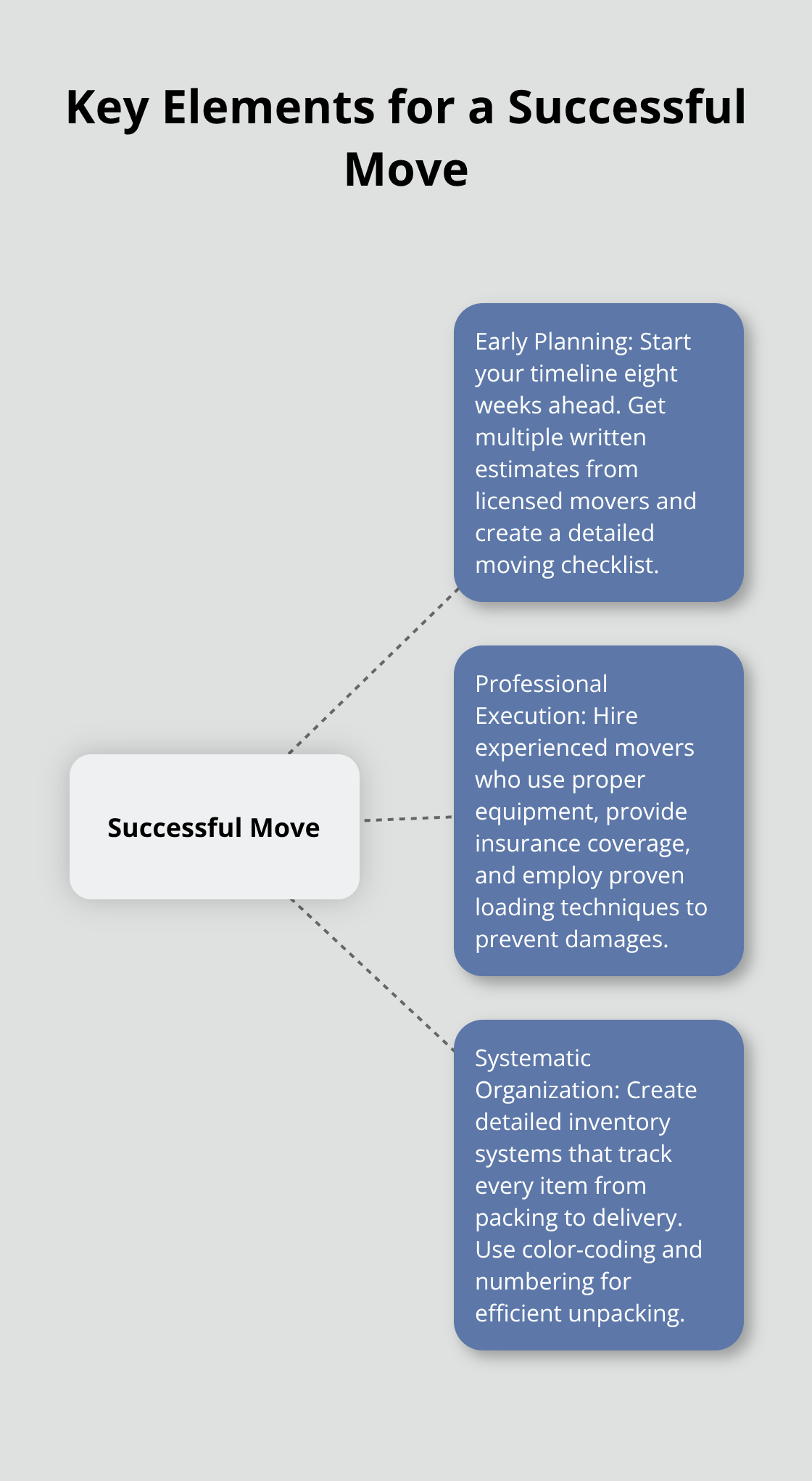Moving your entire house ranks among life’s most stressful experiences, with 73% of people rating it more challenging than starting a new job. Poor planning leads to damaged belongings, budget overruns, and unnecessary headaches.

We at Southbay Moving Systems have guided thousands of families through successful relocations. This comprehensive guide breaks down the moving process into manageable steps that protect your belongings and your sanity.
Planning Your Household Move
The American Moving and Storage Association reports that 60% of people underestimate packing time by at least two weeks. Start your move planning eight weeks before your target date to avoid the panic that derails most relocations. Create a detailed timeline that includes booking movers six weeks out, ordering supplies four weeks ahead, and beginning non-essential packing three weeks before move day. Your checklist should cover utility transfers, address changes with banks and insurance providers, school enrollment paperwork, and vehicle registration updates for interstate moves.
Create a Moving Timeline and Checklist
Break down your move into weekly milestones to stay on track. Eight weeks out, research moving companies and request quotes. Six weeks before, book your chosen mover and order packing supplies. Four weeks ahead, notify your landlord (if renting) and start decluttering. Three weeks prior, begin packing non-essential items and confirm utility transfers. Two weeks before, pack most belongings except daily necessities. One week out, confirm details with your mover and pack a survival kit for your first night.
Set Your Moving Budget and Get Multiple Quotes
Contact at least three licensed moving companies for in-home estimates rather than phone quotes. Your mover must provide you a written estimate of all charges, including transportation, accessorial, and advance charges. Professional movers charge between $25-50 per hour locally and $2,500-5,000 for long-distance moves based on weight and distance. Request binding estimates that lock in your price and verify each company carries proper licensing through the Department of Transportation database. Schedule walkthroughs two months ahead since quality movers book quickly during peak season (May through September). For detailed cost breakdowns, learn more about typical moving house expenses.
Choose Between DIY Moving and Professional Services
Hiring professionals costs 3-4 times more than DIY but prevents the $1,200 average in damages that untrained movers cause to belongings and property. Professional crews complete moves 50% faster and provide insurance coverage that protects your investment. Choose DIY only for local moves under 50 miles with minimal furniture and no fragile items. Factor in truck rental fees, fuel costs, equipment rentals, and potential injury expenses when calculating true DIY costs.
With your planning foundation set, the next step focuses on the systematic approach to packing and preparing your belongings for transport.
Packing and Preparing Your Belongings
Start with rooms you use least and finish with daily essentials. A strategic room-by-room packing approach ensures you maintain functionality in your home until the very last moment while protecting your belongings throughout the process. Begin with storage areas, guest bedrooms, and seasonal items eight weeks before your move. Pack one room completely before you start another to maintain organization and prevent box mix-ups across spaces. Leave bedrooms and kitchens for the final two weeks since these contain items you need until departure day.

Pack Heavy Items in Small Boxes
Use book boxes that measure 16x12x12 inches for anything that weighs over 30 pounds. Standard moving boxes collapse under excessive weight, which causes damage and injury. Pack books flat rather than upright to prevent spine damage during transport. Fill gaps with packing paper to prevent shifting but avoid overpacking beyond 50 pounds per box (professional movers refuse boxes that exceed weight limits, which forces last-minute repacking on moving day).
Create Room-Specific Color Codes and Number Systems
Assign each room a color and number all boxes sequentially. Red tape marks kitchen boxes 1-15, blue identifies living room boxes 16-28, and green signals bedroom containers 29-40. Photograph valuable items before you pack them and maintain a digital inventory spreadsheet that links box numbers to contents. This system helps professional movers place boxes correctly and enables quick unpacking prioritization.
Pack Fragile Items with the Dish Pack Method
Wrap each dish individually in packing paper, then bundle three plates together with additional paper. Stand dishes vertically in boxes like records rather than stack them horizontally to prevent crushing. Use cell dividers for glassware and fill empty spaces with crumpled paper to eliminate movement. Professional packers recommend china barrels for valuable dinnerware since regular boxes offer insufficient protection for fragile items that weigh over 40 pounds per container.
Label and Inventory Systems
Write contents on box tops and sides with permanent markers (sides remain visible when boxes stack). Number each box and record contents in a master list on your phone or computer. Include room destination and priority level for unpacking order. Mark boxes containing essentials with bright colored tape for immediate identification. This detailed system prevents the frustration of searching through dozens of unmarked containers when you need specific items quickly.
Your systematic packing approach sets the foundation for smooth moving day execution, where coordination and logistics determine success or failure.
Moving Day Execution and Logistics
Moving day coordination starts at 6 AM with a final inventory count and ends with signed delivery receipts at your new home. Professional movers arrive within a two-hour window, so prepare a designated parking spot and clear pathways 24 hours before arrival. The Federal Motor Carrier Safety Administration offers free resources and tools to help prepare for your move and to protect yourself from moving fraud. Walk through your home with the crew leader and photograph any pre-existing furniture scratches or wall scuffs to prevent disputes later. Keep your moving contract, insurance documents, and payment methods easily accessible since crews cannot begin work without signed paperwork and deposit confirmation.
Coordinating with Your Moving Team
Assign one family member as the primary contact who stays present throughout the entire process. Moving crews work 40% faster when they receive clear instructions about fragile items, room priorities, and access restrictions upfront. Point out valuable artwork, antiques, and electronics that require special handling techniques. Professional movers use a numbering system that matches your inventory list to each item loaded onto the truck. Take photos of expensive electronics and furniture before wrapping to document their condition.
Final Walkthrough and Documentation
The crew leader should provide you with a copy of the signed inventory sheet before loading begins, which becomes your official record for insurance claims if damage occurs during transport. Walk through each room systematically and verify that movers have noted any pre-existing damage on the official inventory form. Document serial numbers for electronics and appliances (this information proves ownership if items go missing). Check that movers have properly wrapped furniture and marked fragile boxes with appropriate labels.
Loading and Transportation Best Practices
Professional crews load heaviest items first against truck walls to create a stable foundation that prevents shifting during transport. Appliances and furniture go in first, followed by boxes stacked from floor to ceiling in tight formations. Federal law controls maximum gross vehicle weights, with federal limits of 80,000 pounds gross vehicle weight on the Interstate System, so crews weigh loads at certified scales for long-distance moves. Monitor the loading process and speak up immediately if you notice rough handling or improper placement of fragile items. Crews should wrap furniture in moving blankets and use straps to secure loads every six feet of truck length. Your inventory list must match exactly with items loaded, and any discrepancies require immediate notation on the bill of lading before the truck departs your old residence.
Final Thoughts
Three elements determine success when moving your entire house: early planning, professional execution, and systematic organization. Start your timeline eight weeks ahead, get multiple written estimates from licensed movers, and create detailed inventory systems that track every item from packing to delivery. The most expensive mistakes happen when people underestimate packing time, skip professional estimates, or fail to document belongings before transport.

These oversights cost families an average of $1,200 in damages and weeks of additional stress. Professional movers prevent these problems through proper equipment, insurance coverage, and proven loading techniques. After arrival at your new home, prioritize utility connections, security updates, and unpack essential rooms first (change locks immediately since previous owners may have distributed keys to contractors or neighbors).
We at Southbay Moving Systems have guided thousands of Central California families through stress-free relocations. Our licensed professionals handle every detail from packing to storage, backed by transparent pricing. Contact us today to transform your moving experience from overwhelming to effortless.




